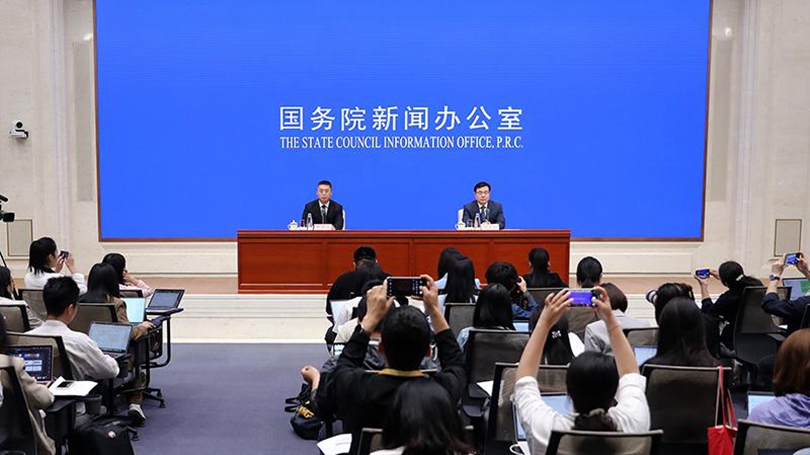21st Century Business Herald:
Based on the data released this year, how would you assess the real estate sector's performance in April? What is the outlook for the sector's development going forward? Thank you.
Fu Linghui:
Thank you for your questions. Another reporter also raised this issue earlier, and I forgot to address it. The real estate sector remained basically stable in April. Of course, conditions vary across different regions, with cities showing distinct trends shaped by factors such as economic growth and population concentration. Overall, however, the real estate market has remained stable.
Since the fourth quarter of 2024, all localities and government departments have worked to implement the CPC Central Committee's decision to restore stability in the real estate market. A series of policies have been introduced to steady the housing market, help people meet their needs for adequate and improved housing, and reduce the cost of home buying. These measures have led to positive progress. Since the beginning of this year, these policies have continued to show results, and the real estate market has been gradually recovering and stabilizing. Based on April's data, the real estate market remained generally stable in both transactions and prices, with some first- and second-tier cities seeing increased transaction activity. The main characteristics are as follows:
First, housing market transactions remained broadly stable. As various policies aimed at stabilizing the property market continue to take effect, property sales have started to recover, with transactions in some cities showing positive trends. From January to April, the sales area of new commercial housing fell by 2.8%. The pace of decline narrowed 0.2 percentage point compared with the January-to-March period. Among 40 key cities, the sales area of new commercial housing increased by 0.1% year on year, while sales volume rose by 2%.
Second, overall housing prices remained stable. In April, across the 70 large and medium-sized cities tracked, sales prices for new commercial housing in first- and second-tier cities remained unchanged from the previous month. In contrast, sales prices in third-tier cities edged down slightly. From a year-on-year perspective, in April, the decline in commercial housing prices continued to narrow across all city tiers among the 70 large and medium-sized cities. Specifically, the year-on-year decline in sales prices for new commercial housing narrowed by 0.7 percentage point in first-tier cities, 0.5 percentage point in second-tier cities, and 0.3 percentage point in third-tier cities. Meanwhile, the year-on-year decrease in sales prices of secondhand homes narrowed by 0.9, 0.5 and 0.4 percentage point, respectively.
Third, housing inventory and new construction activity showed signs of improvement. As property sales have rebounded, real estate developers have reduced their inventories of commercial housing, and new construction activity has picked up. By the end of April, the area of commercial housing for sale had continued to decline compared with the end of March, marking the second consecutive month of decreases. From January to April, the year-on-year decline in the area of new housing construction projects narrowed by 0.6 percentage point compared with the decrease recorded from January to March.
Overall, as a result of various policies aimed at restoring and stabilizing the real estate market, the sector remained largely stable in April. Looking ahead, demand among residents for green, smart and safe housing continues to grow. There is also strong potential for upgrading old neighborhoods and improving the quality and efficiency of housing construction. Nevertheless, the overall property market is still undergoing adjustment and transformation. Demand for both first homes and improved housing has yet to be fully unleashed, and some regions continue to face significant pressure to reduce existing housing inventory. Continued efforts are needed to further stabilize the sector.
Moving forward, we need to earnestly implement the decisions and plans set by the CPC Central Committee and the State Council, and proactively adapt to the significant changes in supply-demand dynamics in the property market. We will strengthen policy coordination, continue increasing the supply of high-quality homes, and actively promote urban renewal projects and the construction of government-subsidized housing. We will also accelerate the development of new growth models for the property sector to better meet people's aspirations for improved living conditions and to promote the steady and healthy growth of the real estate sector. Thank you.
Zhou Jianshe:
Today's press conference is hereby concluded. Thank you, Mr. Fu, and thank you to all our friends from the media. Goodbye!
Translated and edited by Zhang Jiaqi, Wang Xingguang, Liu Caiyi, Xu Kailin, Liu Sitong, Yang Xi, Liu Ziying, Zhang Tingting, Zhu Bochen, Huang Shan, Fan Junmei, Li Huiru, Ma Yujia, Li Xiao, David Ball, and Jay Birbeck. In case of any discrepancy between the English and Chinese texts, the Chinese version is deemed to prevail.


 Share:
Share: 




 京公网安备 11010802027341号
京公网安备 11010802027341号